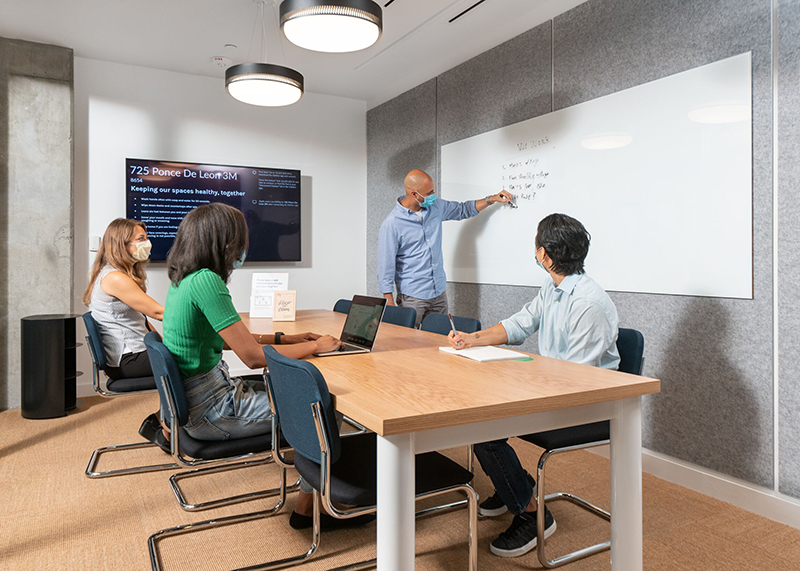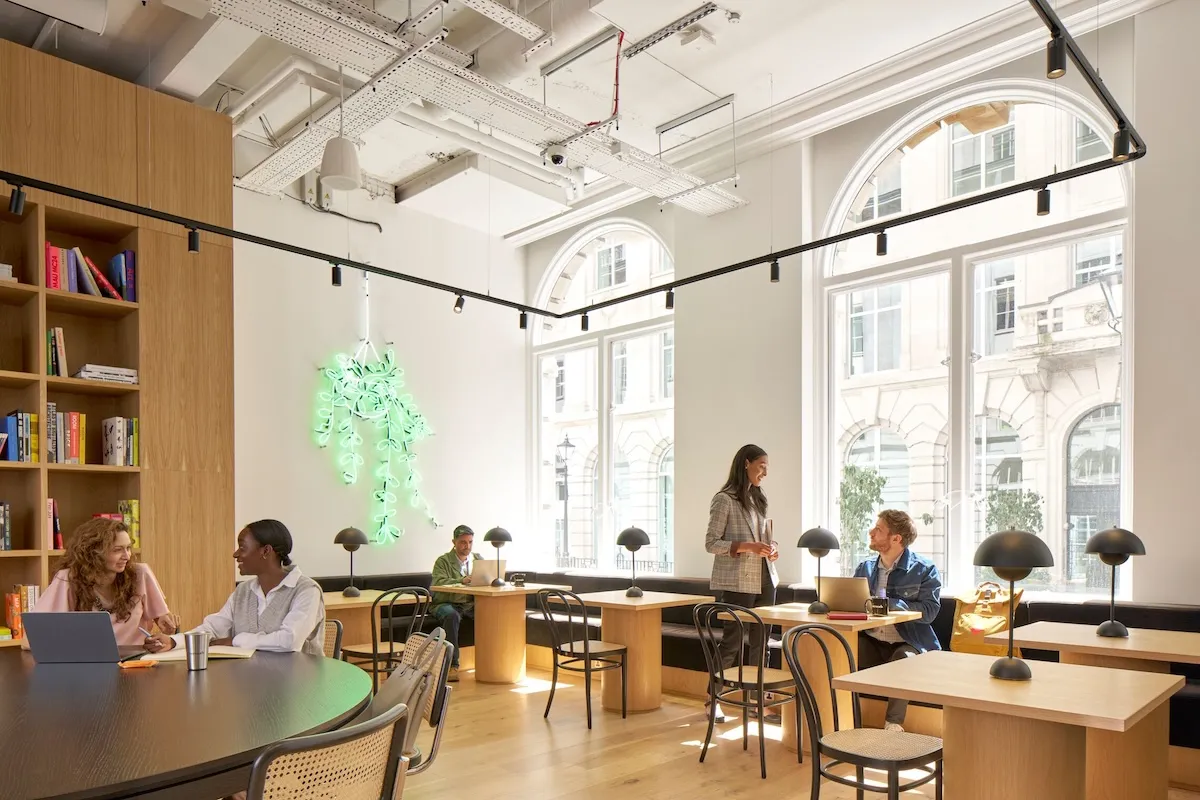The telltale ding of another Zoom invite landing in your inbox might fill you with a certain sense of dread, but virtual meetings are a lifeline for businesses affected by the COVID-19 pandemic. With in-person meetings no longer an option, decentralized teams still have the tools they need to stay connected and collaborate over vast distances, in ways that wouldn’t have been practical just a few years ago.
But as essential as virtual meetings are, the technology isn’t without its shortcomings. Meaning can be lost, faces squished into a grid of thumbnails are less expressive, and people’s attention can gradually wander back to the Instagram feed. In addition to helping us stay productive and unified during the pandemic, virtual meetings have also highlighted exactly what’s so effective about in-person meetings.
So how do you safely host a face-to-face meeting during a pandemic? Before we get into that, let’s first take a look at some of the advantages of meeting in person.
The benefits of face-to-face communication
1. Clearer communication
How often have you been unable to discern the tone of a colleague’s reply to an email? A one-line response, an exclamation point, a stray winking emoji—deciphering meaning over text-based communication can be a minefield, especially when communicating between different cultures or across borders.
Videoconferencing isn’t much better, as body language and other nonverbal cues are stripped away. Psychology Today says that while it’s impossible to determine an exact percentage, at least two-thirds of communication can be nonverbal. Subtle changes in facial expressions, vocal inflections, hand gestures, and eye contact all convey meaning and help ensure the speaker’s message is not misunderstood.
2. Fewer interruptions
Any lag in the connection of a virtual meeting makes it difficult to raise points without interrupting or speaking over another participant. To combat this, some videoconferencing software now includes a “raise hand” feature to signal that you have something to say, but these notifications can be easy for the host of the meeting to miss. They can also be uncomfortable for any participants with meeting anxiety who might already be reluctant to speak up.
At in-person meetings, things work a lot more fluidly. We subconsciously use body language as a social cue to indicate when we are about to begin and finish speaking, as well as when we’re willing to yield the floor to another participant. This prevents stop-start conversation and ensures everybody is being heard at the right time.
3. Stronger relationships
While it’s true that most business interactions take place online—whether that’s over email, virtual meetings, or social media—we continue to place special importance on meeting people in person. According to a Forbes survey, 84 percent of executives say they prefer in-person meetings for their ability to build stronger and more meaningful business relationships.

Face-to-face meetings cement existing social bonds and strengthen relationships. They create time and space for informal small talk that can feel inappropriate or insincere in a more formal videoconferencing situation. A casual chat about football, food, or Netflix before or after an in-person meeting can be just as vital to fostering a good business relationship as anything on the agenda. That’s the difference between meeting and connecting.
An in-person meeting also demonstrates that you value your client’s time and business by showing that you’re willing to make space in your schedule for them. That respect cuts both ways. The clients that take the time to see you in person, rather than just click on an invite link, are your strongest business relations.
4. Builds trust
Face-to-face communication is seen as more trustworthy than email, according to a 2017 study published by the Journal of Experimental Social Psychology. An email, especially an unsolicited one, is viewed as inherently suspicious, while a request made in person is considered more sincere. The inbox—thanks to spam emails and dubious attachments—is something we’ve been conditioned to mistrust.
For that reason, in-person meetings are essential to establishing a baseline level of trust and understanding between two or more participants, especially early on in a business relationship. If you’re pitching a new idea or making a bold request that requires a client to put their faith in you, a face-to-face meeting increases your chance of success.
5. More attentive participants
As much as you try to keep people engaged during virtual meetings, some participants are just naturally more inclined to contribute, leading to an unbalanced social dynamic that actively suppresses good communication. The more introverted team members tend to sit back and passively process what’s being said, while the extroverts will steal the show by leading the conversation and directing the agenda.

An effective host can mitigate this by calling on individuals to share their thoughts at key stages of the call but—especially in larger groups where everybody’s input isn’t always needed—this can be a clunky way to lead a meeting. When meeting face-to-face, these two personality camps can work together with less friction, leading to more productive and positive meetings.
How you can resume having in-person meetings
As we start to filter back into our office spaces, the old rules of hosting face-to-face meetings will no longer apply. Instead, new social distancing guidelines and reduced room capacities mean we’ll have to change up our habits to collaborate effectively and safely. Here are a few ideas to ensure your in-person meetings are as safe as they can be.
1. Avoid busy times
Avoiding crowded spaces is one of the main ways we can slow the spread of COVID-19, so schedule your meeting to take place at a time when fewer people will be using public transportation and elevators. Try to steer clear of the morning and evening rush hours, avoid lunch breaks, and schedule meetings to begin at five or 10 minutes past the hour.
2. Give everyone masks
They might already have their own, but by placing a single-use mask at each participant’s seat, you quietly communicate that the room is a “masks on” area, avoiding any confusion and potentially awkward requests. It’s safe to use either a regular mask or a transparent one. The Centers for Disease Control (CDC) recommends the use of multi-layered cloth masks while indoors, but also says clear masks can be used in places where the wearer might struggle to be understood.
3. Space out chairs

We’re back to Social Distancing 101 here, but to maintain a six-foot distance between everybody at the meeting, you should space out or remove alternate chairs. Stagger the chairs on either side of the table in a zigzag fashion, so that no two people are sitting directly across from one another. At WeWork, conference rooms have been reconfigured to provide more space per person, so you don’t have to worry about moving furniture around before attendees arrive.
4. Open a window
According to CDC research, COVID-19 spreads more easily indoors, partly because of the lack of natural airflow. If you’re able to and it’s safe, open a window or a door to allow fresh air to circulate throughout the room. If opening a window isn’t an option—maybe you’re 50 stories up, or in Michigan—speak with your building manager about the most effective use of the air-conditioning system. WeWork has partnered with industry and health experts to enhance our HVAC systems to track and improve indoor air quality.
5. Provide desk microphones
Large conference rooms use desk microphones as a matter of course, but consider installing them in any meeting room where participants have to raise their voices to be heard. The CDC warns that shouting increases the chances of spreading COVID-19, even among mask wearers. A decent microphone and amplification setup subtly boosts the speaker’s volume throughout the room, and it’s more affordable than you might think. GetVOIP has a great rundown of low-cost conference room microphones.
6. Keep your meetings short
This was great advice even before the pandemic: Have shorter meetings. Share the agenda with your team ahead of time so they have a chance to review it. Stay focused and steer the conversation back on topic if participants are becoming distracted. End with clear action points—“we spoke about X and agreed that Y would do Z”—and aim to wrap the whole thing up in under 30 minutes. The less time you spend inside the meeting room, the more time your team has to be productive, and the less chance there is of transmitting the virus.
7. Avoid food and drink
Conference tables may look wrong without a stainless steel coffee pot and a neat row of tiny sandwiches at the center, but the classic meeting room platter isn’t compatible with social distancing rules. Ask your team to bring their own coffee and keep meetings short enough so nobody feels the urge to reach across the table for a snack.
8. Use meeting software to share screens

Avoid crowding around a single laptop by integrating virtual meeting software into your in-person meetings. If your meeting room doesn’t have a presentation screen, or a client can’t easily connect to it, use Zoom or Google Meet to share screens and presentations directly to everyone’s laptops. If you’ve invited fewer people to the in-person meeting because of the room’s reduced capacity, send those who aren’t present an invite link so they can attend virtually.
Where should your in-person meetings take place?
Simply put, in-person meetings can happen anywhere. You can have a one-on-one with a client while strolling through the park. You can lead an all-hands meeting in a hotel conference room. You can brief a colleague while riding a rollercoaster. You can deliver a presentation in the back of an Uber. But while it’s possible to meet almost anywhere, some options are clearly better than others.
Coffee shops might be the natural home of the freelancer, but the busy environment isn’t conducive to meeting colleagues or clients. Hotels, bars, and restaurants can host meetings for teams of varying sizes but lack the flexibility, amenities, and guaranteed safety of a coworking space. And rollercoasters? Well, all that screaming might make it difficult to stay focused.
Renting a dedicated workspace by the day is the best way to bring your team together again safely. WeWork On Demand is a day pass to more than 190 WeWork locations, and grants you access to stylish meeting rooms and shared workspaces in 17 cities across the United States, with no monthly commitment.
With the WeWork On Demand app, you can reserve a meeting room from $10 per hour and start hosting meetings with clients in a setting that’s professional, convenient, and safe. To unlock hundreds of locations globally, WeWork All Access grants you access to dedicated workspace in over 30 countries.
To get started, download the WeWork On Demand app and create an account to begin exploring locations near you. You can search, book, and pay for available office space from $29 per day, and reserve meeting rooms from $10 per hour. Visit WeWork All Access for access to shared workspace in hundreds of locations around the world.
Steve Hogarty is a writer and journalist based in London. He is the travel editor of City AM newspaper and the deputy editor of City AM Magazine, where his work focuses on technology, travel, and entertainment.
Rethinking your workspace?








